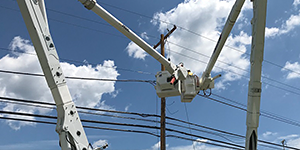OUR APPROACH
We recognize that our electric service is wide-reaching, impacting more than 6 million utility customers who depend on us to provide safe and reliable energy every day of the year. Safety and performance excellence are core values for our company, and we are implementing important initiatives to meet customers' electricity needs today while preparing for increased demand in a clean energy future.
To drive improvement, Energize365 – our five-year, $26-billion grid evolution program – targets investments that enhance the reliability and resilience of our system for customers. Routine infrastructure maintenance and storm preparedness plans also play key roles in our efforts to help ensure service reliability.
Vegetation Management Enhances Reliability
Proactive vegetation management is essential to maintaining a reliable and safe electric system. Our Vegetation Management teams work closely with qualified line clearance crews to ensure both transmission and distribution corridors are clear from vegetation that has the potential to obstruct power lines. We conduct comprehensive assessments to control incompatible vegetation, identify critical hazards, and minimize tree-caused outages across our territory.
Our Vegetation Management teams are industry leaders, utilizing and promoting best management practices to safely maintain more than 2.5 million trees every year. We follow four-year and five-year maintenance cycles for transmission and distribution lines, depending on the state or utility service area. Our vegetation management staff performs inspections and approves all work conducted by vegetation management contractors. Routine inspections of our rights-of-ways are performed to assess treatment effectiveness and identify necessary work to help ensure reliability. We also communicate with property owners, regulatory agencies and customers to provide information regarding our maintenance activities and address any questions or concerns in a timely manner.
Storm Preparedness and Service Restoration
While we continually maintain and invest in the electric grid to deliver reliable service to our customers, storms that bring damaging winds, heavy precipitation and lightning still have the potential to impact our electrical system. Temperature extremes can also affect system performance. From constantly monitoring the weather so we are ready to respond to storm-related outages to staging crews and equipment when inclement weather is expected, FirstEnergy takes many steps to help minimize the time customers are impacted when outages occur.
We have developed and deployed a state-of-the-art forecast modeling tool that helps us predict the scope of impact days ahead of an event. Using extensive available information on factors that influence system performance such as soil moisture, foliage coverage, historical outage data, and more, our model uses Artificial Intelligence (AI) to develop detailed impact forecasts, along with machine-learning to evaluate performance and automatically train itself to improve future outputs.
When severe weather is forecast, FirstEnergy activates formal readiness plans to ensure plenty of service crews are prepared to tackle the damage. Our emergency response processes enable us to respond quickly and safely to a storm or other emergency. Our command and control processes also incorporate key principles and concepts found in the National Incident Management System (NIMS) to help ensure a standardized, consistent and scalable approach to all incidents regardless of size, scope or complexity.
To maintain a state of operational preparedness, we conduct exercises annually to test our training, as well as key systems and tools. These exercises are designed to prepare employees assigned to service restoration duties and review the restoration processes and storm-management tools critical to getting the lights back on quickly and safely. Additionally, we conduct After Action Reviews with affected stakeholders following all major storm events and emergencies to assess our performance and continuously improve our readiness. Corrective Actions are improvement items that result from After Action Reviews. These actions are assigned to specific individuals or groups to help ensure accountability and track completion.
Our FirstEnergy storm preparedness process comprises:
Readiness Plans
When severe weather is forecast, we activate formal readiness plans to ensure our customer contact centers can handle a larger volume of calls and our crews are prepared to safely clear damage and restore service.
Mutual Assistance Relationships
While employees of our operating companies are more than capable of handling most outages, we have mutual assistance relationships with neighboring electric utilities to help us safely and quickly restore power, as the need arises. We also maintain storm response agreements with over 70 contractor partners that can be called upon to supplement available resources as needed.
Emergency Operations Center
System operators at our regional distribution and transmission operations centers monitor weather forecasts around the clock and coordinate our service restoration resources and support as needed.
Power Restoration
After a storm passes and it is safe to assess damage, we identify, assess and mitigate hazards in the interest of safety for our customers and employees. Our dedicated employees and external crews work in shifts around the clock until power is safely restored.
Emergency Communications Plan
We provide appropriate staffing for media coverage during outage events, hold daily conference calls about restoration progress with local officials and emergency management personnel and use social media to share safety reminders and updates.
Estimated Time of Restoration (ETR)
We issue ETRs to provide customers with an expectation of when service will be restored. Customers are notified of changes to ETRs as they are updated.
Industry Recognition for Outage Restoration Efforts

In January 2024, for the 18th consecutive year, FirstEnergy Corp. earned recognition for its emergency response efforts from the Edison Electric Institute (EEI), a leading electric industry organization. EEI presents awards twice annually to member companies to recognize extraordinary efforts to restore power or for assisting other electric companies after service disruptions caused by weather conditions and other natural events. Winners are chosen by a panel of independent judges following an international nomination process. We’re proud to have earned the following award for our restoration response:
